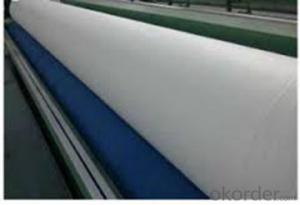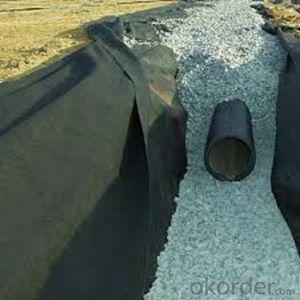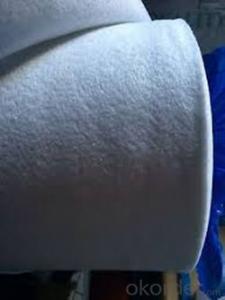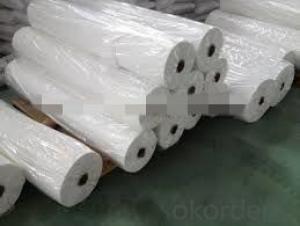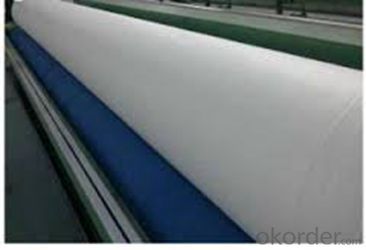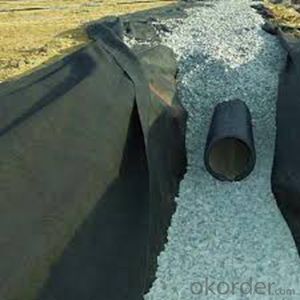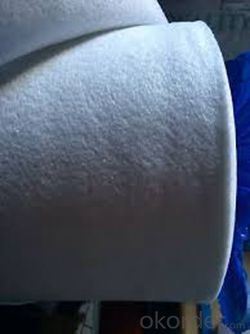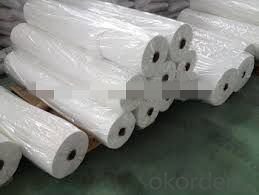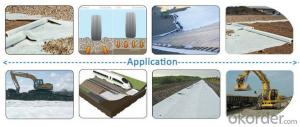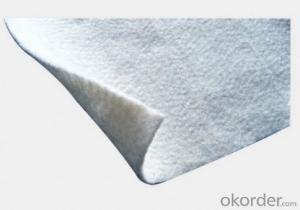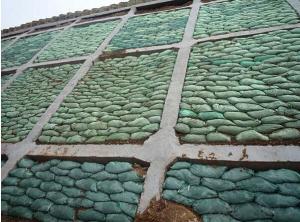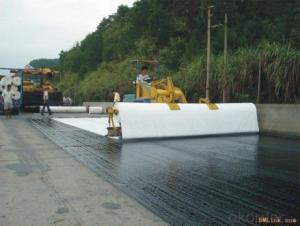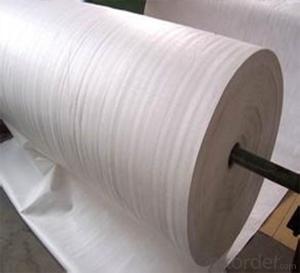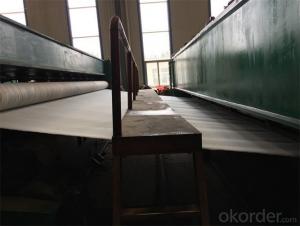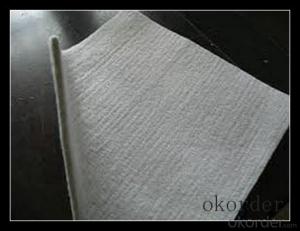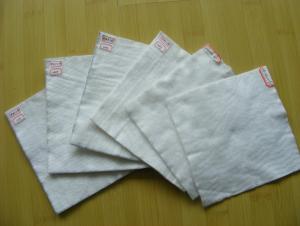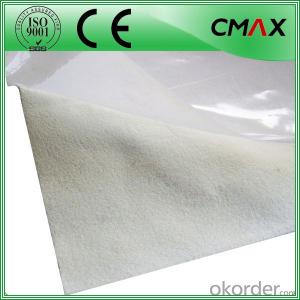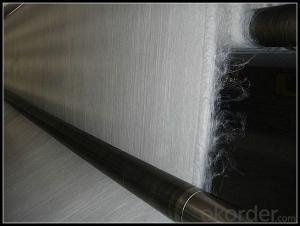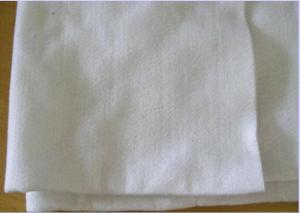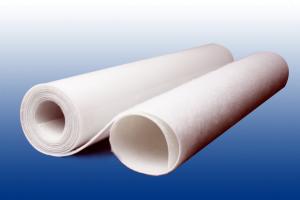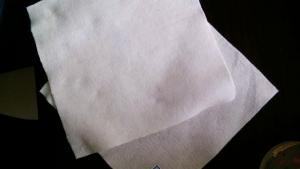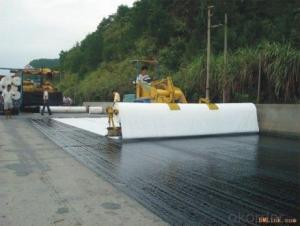100% Polyester Filament Non-woven Geotextile Fabric
- Loading Port:
- China main port
- Payment Terms:
- TT OR LC
- Min Order Qty:
- 1000 m²
- Supply Capability:
- 1000000 m²/month
OKorder Service Pledge
OKorder Financial Service
You Might Also Like
Specification
Filament Spunbond Nonwoven Geotextile Description:
Made from virgin PET(polyester)chips,the continuous filament was
extruded from PET chip by machine directly by spunbond process,
and then punch together to get the stable 3D with higher strength
fabric.So it has high strength, good creep property excellent and
erosion resistance,aging-resistance and heat resistance.
Filament Spunbond Nonwoven Geotextile Property:
Good creep property and hydraulics property,resistance to corrosion,
excellent anti-aging and heat-resistance quality.
Filament Spunbond Nonwoven Geotextile Application:
1.filtration of soils in drainage application by retaining soil particles
while allowing for the free flow of water
2.Separation and reinforcement in road and railway construction
3.Prevention of soil movement in erosion control measures
4.Cushioning and protection in many containment projects
Filament Spunbond Nonwoven Geotextile Production standard:
GB/T17639-2008
JT/T 519-2004
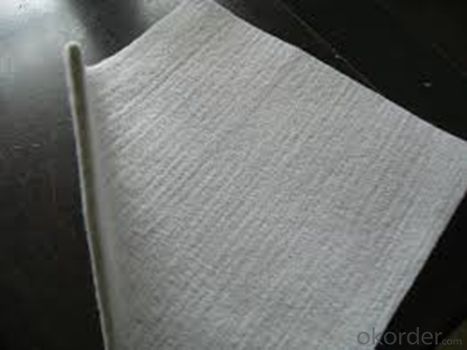
2. Features
Filament geotextile has features as follows: High strength, good capacity of elongation and high biology tolerance, alkali tolerance, acidity tolerance, weather resistance good filtration and fine drainage capacity etc. Also it is of low cost, easy in construction and use effects
3. Geotextile Applications
1) Filtration :
The filtration layer of the dykes, river canal, seacoast, concrete slope, retaining walls. At the same time of preventing the clay granule from passing, it allows the water and the gas pass through freely.
2) Separation :
The isolation of the railway dregs and the roadbed, roadbed and the soft base, surface of the airdrome and parking lot and the groundsill, different dam materials. It isolates the soil and the gravel of two kinds different granule pathway from the groundsill or other buildings.
Packaging & Shipping
Packing: PLASTIC FILM INSIDE, AND WOVEN BAG OUTSIDE
Shipping: About 15 days after receipt the deposit
geotextile fabric
permeability,filtration,easy for construction
ISO and CE certificate
Good quality and competitive price
Our Service
Quality assurance
1.On a regular basis or as per your request,we entrust national testing agencies to conduct quality inspections
2. Strictly in accordance with the ISO9001-2008 international quality system standard,we monitor and manage the whole process throughout production,quality testing,and measurement to ensure product quality
3. For quality-related construction delay or substandard construction(except for damage or losses due to customer’s responsibility or irresistible natural disasters),we have refunding,replacement,and repair services.We will respond to customers’ feedbacks on quality issues within 24 hours.
After-sales service
1.In order to provide customers with comprehensive technical support,we will provide technical and other related information upon request in a timely manner.
2.In required,we will appoint specialized technicians to the construction site to give technical trainings to construction people,and offer technical guidance throughout the whole construction process.
3.For damage due to shipment and delivery,after we receive the complaint,we will check the issure through provided pictures and videos.If our responsibility is confirmed,we wil offer free replacement.
4.When the construction is completed,as your request,our technical staff may participate in the final acceptance.
FAQ:
Q: What kind of payments does jenor support?
A: T/T, L/C, Cash are accepted.
Q: Do you charge for the samples?
A: Accordeing to our company policy, the samples are free, we only charge the freight fee. And we will return the freight fee during the next order.
Q: Can you produce according to customers' design?
A: Sure, we are professional manufacturer, OEM and ODM are both welcome.
Q: Do you have other products?
A: Yes, please check the pictures:
- Q: How do geotextiles help with subgrade stabilization?
- Geotextiles help with subgrade stabilization by providing reinforcement and separation between different soil layers. They improve the strength and stability of the subgrade by distributing loads more evenly, preventing the mixing of different soil types, and reducing the potential for settlement and deformation.
- Q: Geotextile in the asphalt layer under what role
- Geotextile play the role of reinforcement, protection.
- Q: What is the difference between geotextile and impervious geotextile, geotextile and impervious geotextile?
- What is the difference between geotextile and impervious geotextile, geotextile and impervious geotextile?
- Q: How do geotextiles affect water quality?
- Geotextiles can have both positive and negative impacts on water quality. On the positive side, geotextiles can act as a filtration system by preventing sediment and other pollutants from entering water bodies. They can also promote water infiltration and reduce erosion, thus helping to maintain water quality. However, if not properly installed or maintained, geotextiles can become clogged with sediment or create barriers that disrupt natural water flow, leading to potential water quality issues. Therefore, it is crucial to consider the specific design, installation, and maintenance requirements of geotextiles to ensure their positive impact on water quality.
- Q: Can geotextiles be used for reinforcement in asphalt overlays?
- Yes, geotextiles can be used for reinforcement in asphalt overlays. Geotextiles act as a separator and provide reinforcement by distributing stress and preventing the mixing of different layers. They help in reducing reflective cracking and increasing the lifespan of the asphalt overlay.
- Q: How are geotextiles made?
- Geotextiles are made by weaving or knitting synthetic fibers together to create a strong, durable fabric that can be used for various geotechnical applications.
- Q: Can geotextiles be used in drainage applications?
- Yes, geotextiles can be used in drainage applications. They are commonly used to enhance the performance of drainage systems by providing filtration, separation, and reinforcement. Geotextiles can help prevent soil erosion, control sediment, and improve water flow, making them suitable for various drainage applications such as retaining walls, roadways, and agricultural fields.
- Q: How do geotextiles improve soil stability?
- Geotextiles improve soil stability by providing a barrier against erosion, reducing water flow velocity, promoting filtration, and enhancing soil confinement, thereby preventing soil movement and erosion.
- Q: How do geotextiles improve the performance of tunnels?
- Geotextiles improve the performance of tunnels by providing reinforcement, drainage, and filtration. They help stabilize the soil and prevent erosion, leading to increased structural stability and longevity of the tunnel. Additionally, geotextiles can facilitate efficient water drainage, reducing the risk of water accumulation and potential damage to the tunnel. Lastly, they act as a filter, preventing fine particles from clogging drainage systems and ensuring the smooth functioning of the tunnel infrastructure.
- Q: Can geotextiles be used in the protection of embankments?
- Yes, geotextiles can be used in the protection of embankments. Geotextiles are commonly used in civil engineering projects to enhance the stability and performance of embankments. They can help with erosion control, soil reinforcement, and drainage, reducing the risk of slope failures and enhancing the overall durability of the embankment.
Send your message to us
100% Polyester Filament Non-woven Geotextile Fabric
- Loading Port:
- China main port
- Payment Terms:
- TT OR LC
- Min Order Qty:
- 1000 m²
- Supply Capability:
- 1000000 m²/month
OKorder Service Pledge
OKorder Financial Service
Similar products
Hot products
Hot Searches
Related keywords
